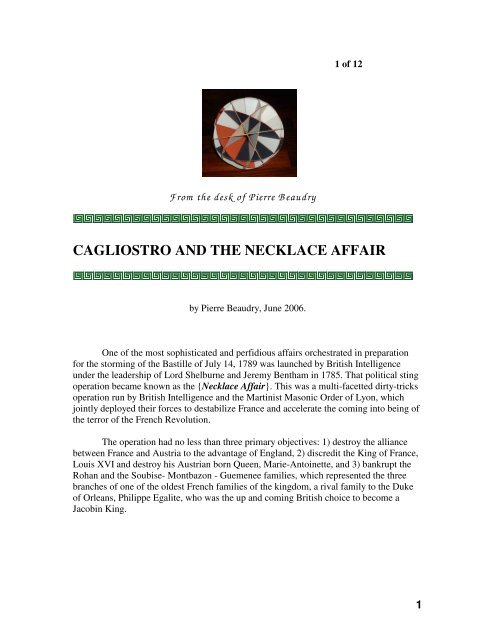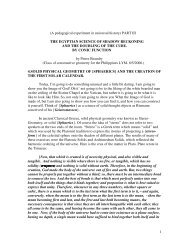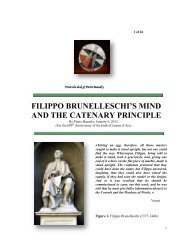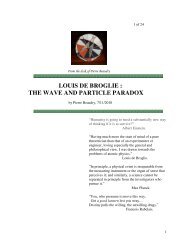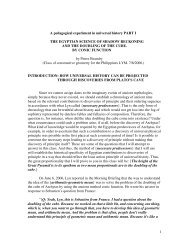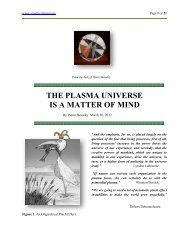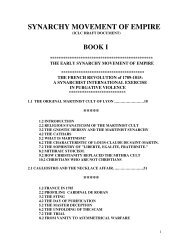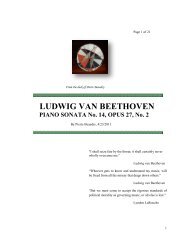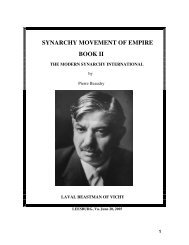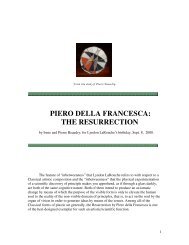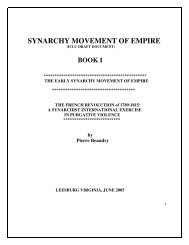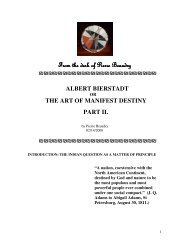CAGLIOSTRO AND THE NECKLACE AFFAIR
CAGLIOSTRO AND THE NECKLACE AFFAIR
CAGLIOSTRO AND THE NECKLACE AFFAIR
Create successful ePaper yourself
Turn your PDF publications into a flip-book with our unique Google optimized e-Paper software.
1 of 12F rom the desk of P ierre B eaudry<strong>CAGLIOSTRO</strong> <strong>AND</strong> <strong>THE</strong> <strong>NECKLACE</strong> <strong>AFFAIR</strong>by Pierre Beaudry, June 2006.One of the most sophisticated and perfidious affairs orchestrated in preparationfor the storming of the Bastille of July 14, 1789 was launched by British Intelligenceunder the leadership of Lord Shelburne and Jeremy Bentham in 1785. That political stingoperation became known as the {Necklace Affair}. This was a multi-facetted dirty-tricksoperation run by British Intelligence and the Martinist Masonic Order of Lyon, whichjointly deployed their forces to destabilize France and accelerate the coming into being ofthe terror of the French Revolution.The operation had no less than three primary objectives: 1) destroy the alliancebetween France and Austria to the advantage of England, 2) discredit the King of France,Louis XVI and destroy his Austrian born Queen, Marie-Antoinette, and 3) bankrupt theRohan and the Soubise- Montbazon - Guemenee families, which represented the threebranches of one of the oldest French families of the kingdom, a rival family to the Dukeof Orleans, Philippe Egalite, who was the up and coming British choice to become aJacobin King.1
of Bretagne, was the leader of the Calvinist party under Louis XIII. If the Protestantshad won the war against the Catholics, Henry I would have become King of France.Later, Louis de Rohan (1635-1674), colonel of the guards of Louis XIV, took part ina conspiracy against the king by organizing a landing of Dutch forces in Normandy.He failed and was decapitated. Then, Prince Louis Rene Edouard de Rohan, Cardinalof Strasbourg (1734-1803), had been the Ambassador of France to Vienna, and was aclose ally to the Empress, Marie-Therese. In fact, the first reception that Marie-Antoinette was graced with, when she first came to France occurred in Strasbourg, atthe princely house of Cardinal de Rohan. The Rohan family also had three Princesseswho had married into the Bourbon family throughout the centuries, which gave theRohan name an even greater prestige, such that no other family of France had agreater uninterrupted princely bloodline, outside of the Bourbon royal family itself.The Cardinal was also a Prince of the Empire. Furthermore, Mme Rohan - Guemeneebecame the first governess of Louis XVI and Marie-Antoinette's children, before theroyal children became governed by the British controlled Polignac family, whichturned out to be so destructive for the Queen.Meanwhile, after having been initiated into the mysteries of the Knights ofSaint John and Jerusalem by Pinto, the supreme Knight Commander in the Isle ofMalta, a so-called Comte de Cagliostro (whose real name was Joseph Balsamo, bornof ordinary folks in Palermo Sicily at about 1743), was deployed to Venice, London,and then Vienna, before being sent to Strasbourg, and from there, to Paris.After several years of travel, a renowned alchemist and mystificator, the 33-degree freemason Grand Master, known as Count de St. Germain, initiated Cagliostrointo the esoteric art of charlatanism, in a castle of Holstein in Germany. Count de St.Germain was an imposter who had made a fortune in Germany by selling an elixir ofyouth to arrest the progress of aging. Another known scoundrel of that period,Voltaire, claimed that Saint.-Germain was, in reality, a paid agent of William Pitt theYounger.It was during the early 1770's that St. Germain revealed to his pupil the "greatsecret", which gave Cagliostro the so-called powers of the "divine mysteries ofimmortality". St. Germain made the claim that he was at least five hundred years old,and often spoke of Henry VIII and Charles V as if these monarchs had spentdelighted moments in his company. Cagliostro was told that he should also delight thegood society into having them believe any absurdity he chose to utter. St. Germaintold Cagliostro:"{Know that the great secret of our art is to govern men, and that the onlymeans to succeed is to never tell them the truth. Never conduct yourself accordingto the rules of common sense; brave reason, and courageously produce the mostunbelievable absurdities. Remember that the first resource of nature, of politics, ofsociety, is reproduction; that the chemistry of the mortals is to be immortal, to knowthe future, while they even ignore the present, to be spiritual while everything theyare and which surrounds them is material.}" (Louis Figuier, Op. Cit. p. 99)3
Cagliostro was being groomed for the most important mission of his life,which was to be executed against a person of high rank in the French aristocracy.From his teacher St. Germain, he learned that the greatest resource the aristocracycould provide a skillful manipulator was its own vanity, and that there was no greaterbeliever than the credulity of a vain aristocrat who desired to believe in his owndelusions. The plan was to take full advantage of the weakness of this aristocrat androb him blind. After all, thought Cagliostro, why not take advantage of the other,especially when he is so completely willing to be duped.In accordance with this anti-principle of the Peace of Westphalia, Cagliostromade a profile study of Prince Louis Rene Edward Cardinal de Rohan. He discoveredthat there was nothing more attractive to the vanity of the Cardinal, who could not beKing, than to accede to the position of being apart from all other peers of the kingdomby becoming intimately close to the Queen. His family motto was: "{King I cannotbe; prince I do not dare; Rohan I am!}" He was even convinced that only a Rohancould succeed in presenting himself before the Queen without being introduced andwithout offending her. Thus, Cagliostro knew that the greatest desire of the Cardinalde Rohan, the ultimate peak of his vanity, was to be seen in Versailles as one of theclose friends of the Queen of France, Marie-Antoinette.As a former Ambassador to Vienna, and personal friend to Marie Antoinette'smother, the Empress Marie-Therese, Rohan wished nothing more than to be acceptedby the Queen who, personally, had nothing but resentment for him. In his capacity ofRoyal Chaplain, the Cardinal presided over the royal services, at Versailles, but theQueen was determined to not even give him even a passing look.<strong>THE</strong> STINGDuring the month of May 1785, after the royal jewelers, Bohmer andBassanges, offered to sell the King their best diamond necklace, evaluated at thehandsome sum of 1,600,000 francs, the British assets around the French court wastedno time in circulating the rumor that Marie-Antoinette was highly interested inpurchasing the necklace.Prince Cardinal Louis de Rohan got wind of the story, but let the thought slipthrough the sieve of his mind until a certain Madame La Motte approached him,during the summer of 1785. Madame La Motte was a phony Countess in the employof Cagliostro. She claimed to be of the Valois bloodline, which gave her access to theservant's door of the Queen's household in Versailles. She reminded Rohan about theQueen wanting the necklace, and how she was very unhappy because she did not dareupset the King by asking him to pay for such a wonderful object.Madame La Motte then asked Rohan if he knew of anyone of high rank, whowould be discrete and could be trusted enough to do such a great service for theQueen as to front the money for her. "You see," said Madame La Motte, "the Queen4
said she was willing to buy it with her own money, but that she could not come upwith such a sum all at once, and that she only wished she could count on thediscretion of a great friend, who would be kind enough to oblige her until she couldpay the money back: a friend that could be trusted enough to receive the necklace onher behalf." (Louis Figuier, Op. Cit., p.57)The vanity of Cardinal de Rohan had been touched. And since there existed nomeasure more convincing than to have someone confirm his self-delusion, Rohanimmediately replied. " Since the King would not put up the money, I will help theQueen. I shall become the secret buyer of the said necklace.""The Queen," Madame La Motte told Rohan, "was willing to pay for it withher own money, but in several installments."Several days after this first meeting with the Cardinal, Madame La Mottecame to the Prince again, but this time with a letter from the Queen, which had beencarefully crafted by a friend of her husband's, the Sieur Retaux de la Villette, anexpert counterfeiter in handwritings, who was also in the employ of Cagliostro. Onlytoo willing to serve her Majesty blindly, Rohan recognized immediately thehandwriting of Marie-Antoinette, which stated that she had accepted the good officesof the Cardinal and that she authorized him to buy the necklace secretly in her name.Prince Rohan, wishing nothing more than to be in the Queen's favor, saw noproblem in buying the necklace, however, just to be on the safe side, he called uponCagliostro for his advice. Cagliostro had already entered into Rohan's favor, a fewweeks earlier, by saving the Cardinal’s brother from certain death, but made sure thathe was not perceived as being a party to the antics of Madame La Motte. If there wasa miracle doctor anywhere in Paris, who Rohan could trust with his own life, it wasCagliostro.Cagliostro immediately refused the proposition of the Cardinal in order toestablish a judicial distance from the affair for the future, and forced Rohan into abegging position. Cagliostro responded categorically: "If the Cardinal is sick, let himcome and I shall cure him; if he is well, he has no need of me, nor me of him."Although the reply was somewhat brutal, Rohan was not offended by his negativeresponse; to the contrary, he found himself in such a pressing situation that heinstantly sent Madame La Motte to plead with Cagliostro. After several pleadingsessions, Cagliostro finally gave in and gave Cardinal de Rohan the following oracle."{The negotiation undertaken by the prince is deserving of him; it will betotally successful; it will produce the highest favors from the Queen, and will causethe kingdom of France to prosper without compare, under the influence, thetalents, and the preponderance of Louis de Rohan.}" (Louis Figuier, Op. Cit., p.60)The Cardinal could not hope for a better answer from Cagliostro. He was nowconvinced that there could not be a more beautiful opportunity to reconcile him withthe Queen, and to restore her good grace in his favor. On January 30 th 1986, the5
Cardinal received the necklace and signed the promissory note that Boehmer asked ofhim.ON <strong>THE</strong> DAY OF PURIFICATIONMadame La Motte told the Cardinal that the intention of the Queen was to wearthose jewels at the celebration of mass on the day of Purification, but that she would havesomeone come to her place, in Versailles, for the diamonds. The Cardinal believed herand gave her the necklace for safekeeping. A complicated ceremonial was devised so thatthe Cardinal could witness the necklace changing hands between Madame La Motte andthe chamber valet in the service of the Queen at the Trianon, without himself being seen.The Cardinal witnessed the scene and was in seventh heaven.On the next day, the Day of Purification, the Cardinal entered the chapel tocelebrate mass and was devastated to see that the Queen had come to the chapel withoutthe magnificent set of jewelry. She wore no necklace at all. And to make matters worse,the Queen seemed to ignore the Cardinal more than ever, as she did not even look at himduring communion. He was so confused that, during that after-noon, the Cardinal wentdashing to the house of Madame La Motte, demanding an explanation of what wentwrong. Madame La Motte calmly reassured the Cardinal immediately by saying:"Monsignor, don't you have in you possession the letter of Marie-Antoinette,which says that she consents in accepting your mediation, and who assures you of hergratefulness? What can you fear with this piece of evidence? The Queen can only changeher attitude towards you in a gradual fashion, so as to not awaken suspicion at the court.She has too much finesse to precipitate such a change of attitude towards you. This wouldcreate a lot of commotion, and initiate a thousand and one suppositions, one moreunfortunate than the other." (Louis Figuier, Op. Cit., p. 62)The Cardinal was reassured and calmed down, but things had suddenly becomemore complicated for Madame La Motte. By that time, the necklace was already inLondon, being sold in pieces by her husband, Comte de La Motte, who had beenaccompanied out of France by the false chamber valet of the Queen, Retaux de laVillette. However, there came a moment when the Cardinal wished to have a meetingwith the Queen because he considered she took too long to change her attitude towardshim. To confirm his suspicions, not only the Queen never appeared in public wearing thediamonds, but also her coldness toward him had not changed at all. Meanwhile, MadameLa Motte kept reassuring the Cardinal, but could not keep up the scam much longerwithout the creation of new letters from Marie-Antoinette.After Villette returned from London, Madame La Motte used his expertise again,and produced a new letter from the Queen, whose handwriting was again recognized bythe Cardinal, who was moved to tears by the affection the Queen expressed toward him.However, there was no mention of the first installment of 300,000 francs that the Queen6
'Here comes the Countess of Artois who is looking for me, we must part.'"M. de Rohan left the thicket immediately in the opposite direction. Hejoined the Baron of Planta and Mme de La Motte and explained to them theunfortunate situation with total chagrin. He suspected nothing." (Jules de SaintFélix, {Aventures de Cagliostro}, 1855, p. 131-133.)Although, the Cardinal was tormented, he was also totally infatuated by thedeclaration of his "royal lover." To further aggravate his new state of drunkenness,Madame La Motte dropped by the house of the Cardinal the next morning and handedhim a new letter in which Marie-Antoinette expressed her total regrets about theunfortunate interruption of the night before. In his infatuated enthusiasm, the Cardinalhad forgotten all about the 300,000 francs and made immediate arrangements toborrow the sum.<strong>THE</strong> UNFOLDING OF <strong>THE</strong> SCAMA few days later, the jeweler Boehmer was by chance called by Marie-Antoinette to bring her back a repaired ornament. Boehmer gave the Queen a note inwhich he said: "I congratulate Your Majesty for possessing the most beautifuldiamonds known in Europe, and I beg of her not to forget me." After Boehmer hadleft, the Queen read the note and said to her Dame de Chambre, Madame Campan:"He is crazy." The Queen then sent Madame Campan to the jeweler for anexplanation. After Boehmer told her the entire story of his selling the diamondnecklace to Cardinal de Rohan, Madame Campan realized that the whole thing hadbeen a scam, and told the jeweler: "{Monsieur Boehmer, you have been robbed ofyou diamonds, The Queen knows nothing of this.}"A few days later, the King summoned Cardinal de Rohan to his cabinet andsubjected him to a systematic interrogation. The King was furious. Cagliostro'sbiographer related the events in the following manner:"{Louis XVI suddenly addressed M. de Rohan. It was a veritableinterrogation session. The Prince overwhelmed, responded by mumbling. Marie-Antoinette, pale with anger, kept silent, without even looking at the Cardinal.However, the latter, attempting to reach for an extreme means of justification,extracted from his pocket a letter, which he said, was from the Queen andaddressed to Madame de La Motte. Marie-Antoinette made a nervous move ofindignation. Her eyes were sparkling. The King took the letter, read it rapidly, andgiving it back to the Cardinal, he said: 'Sir, this is neither the handwriting of theQueen, neither her signature. How can a prince of the House of Rohan, how canthe grand almoner of the crown, believe that the Queen would sign Marie-Antoinette de France? Nobody ignores that queens sign only their Christian name."The Cardinal remained silent.8
"But, explain to me what this whole intrigue is about," said the King withextreme impatience."The cardinal, was leaning against the table; he was getting pale, and couldonly respond these words:"Sire, I am to much troubled to be able to explain myself before YourMajesty.""The King continued with more benevolence:"Get a hold of yourself, Monsieur le Cardinal. Go to the next room, whereyou will find what you need to write on. I do not wish to find you guilty."M. de Rohan went to the other room.}" (Louis Figuier, Op. Cit., p. 68)The next day, the Cardinal was taken to the Bastille. On the same day,Madame La Motte was arrested and also brought to the Bastille. Retaux de la Villettewas also caught, but the Comte de La Motte escaped to England. As for Cagliostro,he was arrested in his alchemy laboratory of rue Saint-Claude, in Paris, and was alsothrown into the Bastille. All of the accused were later brought before a commission ofthe parliament.<strong>THE</strong> TRIALAt the request of King Louis XVI, the Parliament of Paris opened an investigationon what was still an obscure plot contrived by unscrupulous swindlers, and apparentlyaimed at destroying the character of the Queen of France. The Conde, the Rohan, theGuemenee, the Soubise families, were all present. They were all dressed in black, andwere accompanied by no less than forty-nine members of the high clergy, all dressed inred, among whom Cardinal de Rohan, Grand Almoner of the kingdom, stood with dignityand perfect countenance.The court case was a travesty of justice in which Madame de La Motte got theblunt end of Justice and Cagliostro, who had been the mastermind of the whole operation,was acquitted.The decision of the parliament was read as follows:"{La Motte, contumacious, is condemned to the gallows at perpetuity."Madame La Motte will be wiped. She will be marked on the two shoulders with theletter V and incarcerated in the hospital [Salpetriere] at perpetuity."Retaux de Villette is banished forever from the kingdom;"Demoiselle Oliva is acquitted by the court;"Sir Cagliostro is discharged of accusation;9
"Cardinal de Rohan is discharged of all accusation.}" (Louis Figuier, Op. Cit., p. 111.)The plan to destroy Marie-Antoinette had failed, but the negative publicity againsther dominated public opinion for several years. Though he had been acquitted, Cagliostrowas told to leave Paris within twenty-four hours. He went to assist the Martinists of Lyonby spending three weeks of masonic "rituals" in Passy, where Benjamin Franklin lived.On June 20, 1786, Cagliostro left Boulongne-Sur-Mer for London, where he wrote his{Letter to the French People}, a political pamphlet against the Monarchy, against theMinisters and against the Parliament of France. Cagliostro had all of a sudden becomevery political and seemed to have espoused a revolutionary cause.FROM VANITY TO ASYMMETRICAL WARFARECagliostro's political diatribe against the French Monarchy represented, in reality,an admission of his terrorist proclivity. His pamphlet included a self-fulfilling prophecy,which announced, three years before the fact, that the Paris Bastille Prison was beingplanned for destruction. At the end of June 1786, Cagliostro wrote from London: "{TheBastille will be destroyed from top to bottom, and the land on which it was erected willbe converted into a promenade.}" (Louis Figuier, Op. Cit., p.119) With this statement,Cagliostro revealed himself completely before the court of justice of history. He wasactually confirming that he was, indeed, an agent of British Intelligence, which can alsobe confirmed in the following manner.According to British historian, Charles Mackay, Cagliostro began a publicitycampaign in earnest against the Queen of France as soon as he got to London.Cagliostro's Paris failure was obviously not well received by his British masters. The firstphase of the Bastille project had not gone according to plans and Cagliostro's deploymenthad to be changed. Mackay reported: "On his arrival in London, he [Cagliostro] made theacquaintance of the notorious Lord George Gordon, who espoused his cause warmly, andinserted a letter in the public papers, animadverting upon the conduct of the Queen ofFrance in the affair of the necklace, and asserting that she was really the guilty party. Forthis letter, Lord George was exposed to a prosecution at the instance of the Frenchambassador, found guilty of libel, and sentenced to fine and a long imprisonment."(Charles Mackay,{Popular Delusions and the Madness of Crowds} original edition,London, Richard Bentley, 1841, Wells, Vermont, L.C. Page & Company, 1969, p. 254.)As a result of this new scandal, Cagliostro was forced to retire from his career as acharlatan, and was sent back to France as a terrorist and mob controller in preparation forthe revolution. According to Father Gregoire and Joseph d'Orleans, Cagliostro founded aJacobin type of Masonic Lodge in Paris under the initials L.P.D., which stood for {LiliaPedibus Destrue}, (Destroy the lilies under your feet). The lilies were the symbolicflowers of the Bourbon dynasty.10
In 1788, an associate of Cagliostro from Lyon, Knight of Malta freemasonCazotte, also made a prophecy during a dinner at the table of the Duke of Nivernais. Hepredicted that no less than four members of the Academy of Sciences sitting at the dinnertable would be dead within six years. Cazotte had identified the allies of BenjaminFranklin, Marquis de Condorcet and Felix Vicq-d'Azyr, who were both suicided inprison. He also announced that Dr. Nicolai Roucher and Jean Sylvain Bailly would dieunder the guillotine, and they did.When one looks for [Qui Bono} and discovers that both Cagliostro and Cazottewere leading masons associated with the Martinist freemasons of Lyon, and wereassociated with British Intelligence operatives, like Lord George Gordon, it becomes easyto put the pieces together and establish that such self-fulfilling prophecies as the Fall ofthe Bastille and the prediction of political assassinations of key French leaders werenothing but British-Freemasonic operations run out of London.That masonic collaboration between Gordon and Cagliostro would have beenclassified as a mere coincidence had Lord George Gordon not been the BritishIntelligence operative who launched the infamous London riots of June 1780, whichcame to be known as the "Gordon Riots."On June 7 th of that year, Gordon led a mob to storm the strongest prison inEngland, the Newgate London Prison, which was completely burnt and demolishedwithin a few hours. The same scenario was to be repeated on July 14, 1789 at the ParisBastille prison, prepared by a similar British Intelligence operation with the collaborationof the Duke of Orleans, Philippe Egalite, the Martinists of Lyon led by Cagliostro andJoseph de Maistre, and with the help of two Swiss-British agents, French FinanceMinister Jacques Necker and Military Commander Baron Bensenval. Both terroristprojects had, indeed, been prepared by Lord Shelburne and Jeremy Bentham to serve asmodels for modern Synarchist-run {purgative violence}, which are today known asterrorist asymmetrical warfare.The irony of Gordon's earlier terrorist trial lies in the fact that his lawyer got hima quick acquittal after stating to the court that he had been guilty "of nothing more thanhare-brained and criminal folly in heading an unlawful assembly. " However, accordingto historian Richard Morris, this "criminal folly" did result in the loss of quite a few lives."Of the 135 arrested and tried for taking part in the [Gordon] riots, 59 were sentenced todeath and 21 duly executed. Among the assorted ruffians who paid the extreme penaltywas the public executioner, Edward Dennis, the wretched hangman of infamous memoryin Barnaby Rudge, who participated in the burning." (Richard B. Morris, {ThePeacemakers}, Harper & Row, Publishers, New York, 1965, p. 83.) The ExecutionerDennis, however, may have played a role model for Joseph de Maistre's executionerduring the French revolution.After the fall of the Bastille, Cagliostro made his fatal mistake. His terroristdeployment in France had succeeded and instead of going back to safety in England, hewent to Italy. He dared to propagate his freemasonic doctrine in the anti-masonic capital11
of the world. After the founding of his Egyptian Lodge, in Rome, Cagliostro was arrestedby the pontifical police on September 27, 1789, and was tried for his crimes perpetratedunder free-masonic cover. His trial lasted eighteen months, at the end of which, he wascondemned to death under the January 14, 1739 Anti-Masonic Bulle of Pope ClementVII. But a more lenient Pope Benoit XIV commuted his sentence to life imprisonment.Cagliostro died a few years later in his jail cell.FIN12


